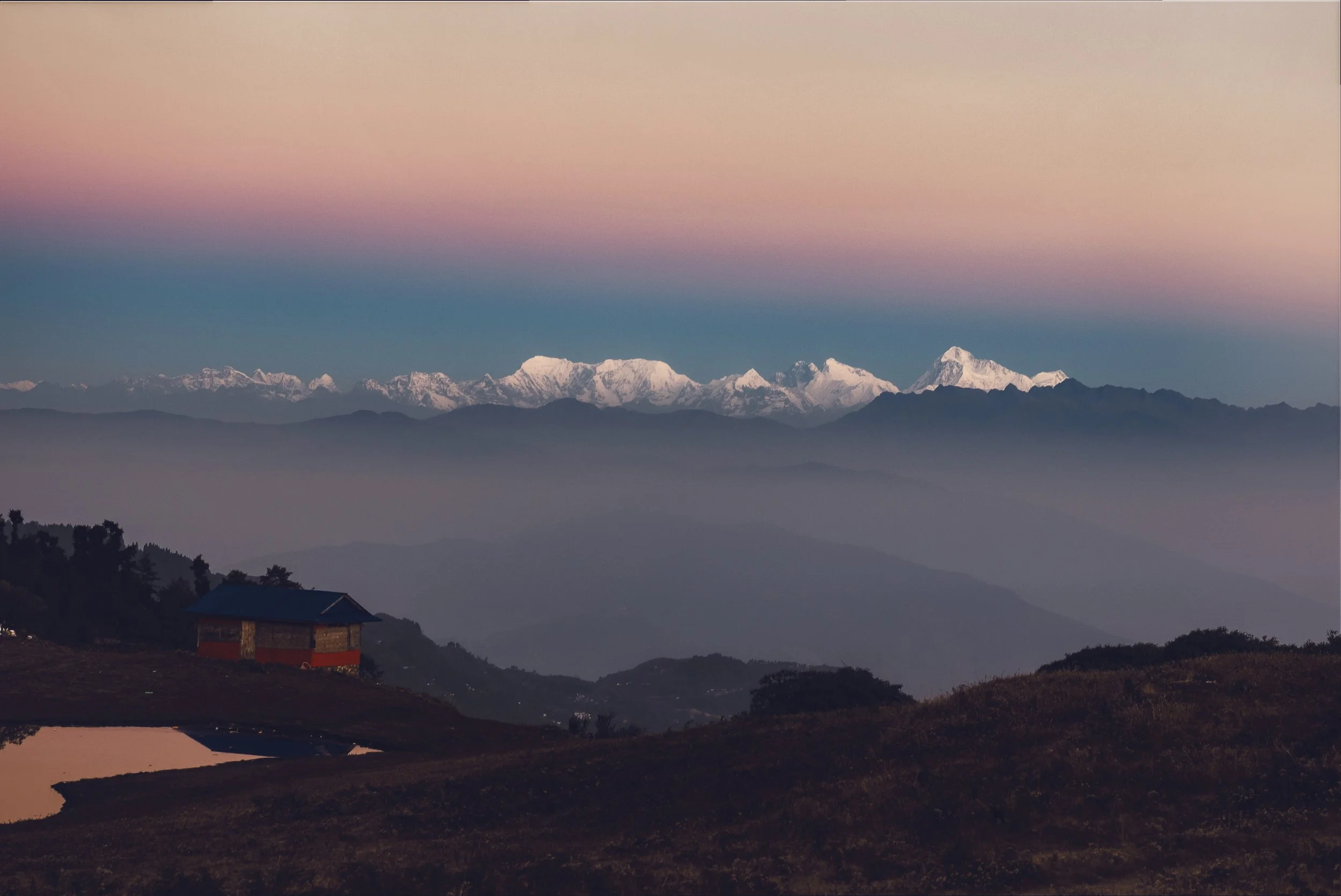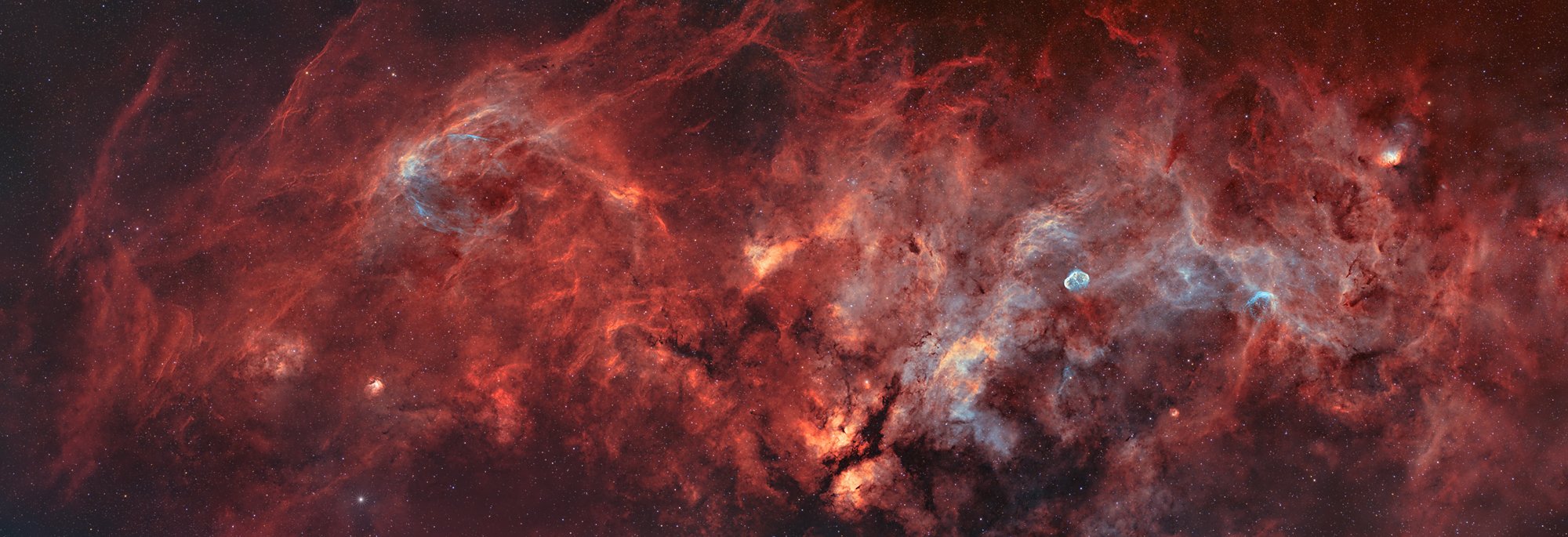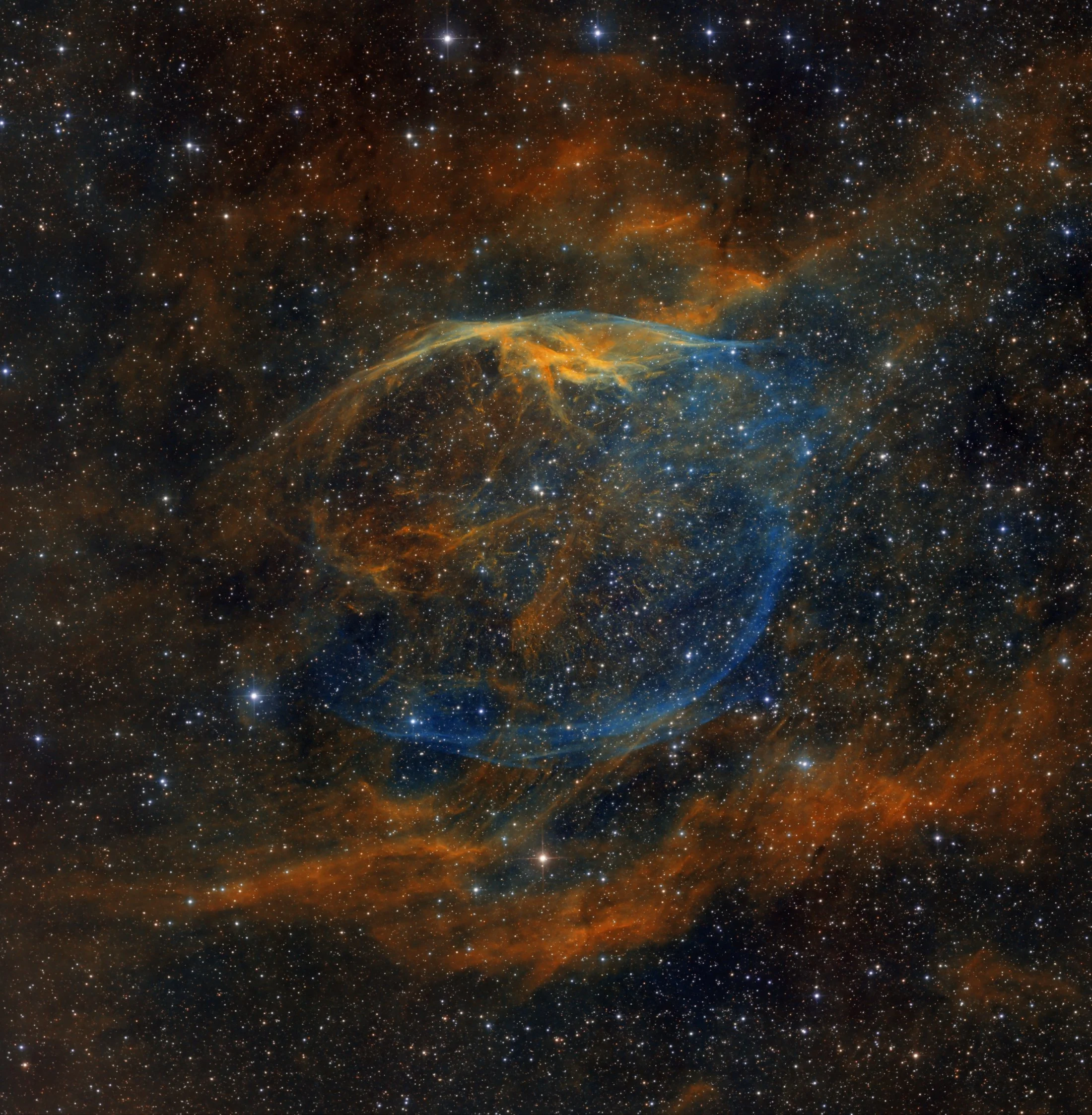
AAPOD2 Image Archives
The Black Eye Galaxy
Image Description and Details : The Black Eye Galaxy, or M64, is located 17 million light-years away in the constellation Coma Berenices. Its nucleus is packed with impressive dust lanes laden with rigorous star formation. Charles Messier added this galaxy to his list in 1780, but it had already been discovered by English astronomer Edward Pigott in 1779.
Acquisition Date: April 24 - May 10, 2023
Equipment: Planewave CDK12.5, Astrodon LRGB, ZWO ASI2600MM
Integration: 25 hours
- L: 119 x 300s
- R: 58 x 300s
- G: 64 x 300s
- B: 65 x 300s
Processed in PixInsight
Copyright: Carl Crum
SH2-54
Image Description and Details : Sh2-54 with my dual Setup of a TS80 and TS130 as SHO with (partial) RGB Stars from the TS130.
I have double checked all data and the lower left dark nebula is a bit stronger in S-II line.
27:42h total capture time:
Astronomik Deep-Sky Blue 36 mm: 33×180″(1h 39′)
Astronomik Deep-Sky Green 36 mm: 25×180″(1h 15′)
Astronomik Deep-Sky Red 36 mm: 26×180″(1h 18′)
Astronomik H-alpha CCD 6nm 36mm: 43×300″(3h 35′)
Astronomik OIII CCD 6nm 36 mm: 30×300″(2h 30′)
Astronomik SII CCD 6nm 36 mm: 33×300″(2h 45′)
ZWO H-alpha 7nm 36mm: 62×300″(5h 10′)
ZWO O-III 7nm 36mm: 55×300″(4h 35′)
ZWO S-II 7nm 36 mm: 59×300″(4h 55′)
Copyright: Philip Mair
The Southern Tadpoles in NGC 3572
Image Description and Details : Integration time= 15h 17′ 30″
Imaging Telescopes Sky-Watcher Esprit 150ED
Imaging Camera QHY16200A
Mount Sky-Watcher EQ8-RH
Filter Antlia 3.5nm Narrowband H-alpha 2" · Antlia 3.5nm Narrowband Sulfur II 2" · Baader Blue (B-CCD) 2" · Baader Green (G-CCD) 2" · Baader Red (R-CCD) 2" · Chroma OIII 3nm Bandpass 2"
Copyright: Christian Hilbert
Field on Sh2-99 and Sh2-100
Image Description and Details : Very happy to share with you this photography which is to date, is the one where I realized the most exposure time : 37H30.
Realized between May 29 and June 15, 2023.
It is a colorimetric assembly, with SHO, HOO, and RGB layers.
SH2-99 and SH2-100 are emission nebulae visible in the constellation Cygnus, at the edge of a very bright stretch of the Milky Way. These small regions of ionized hydrogen are located at a distance of approximately 26,000 light-years and 28,000 light-years respectively from us.
Exifs :
S : 31x600s - H : 85 x 600s - O : 73 x 600s
R : 110 x 60s - G : 110 x 60s - B : 140 x 60s
Sharpstar Optics Askar FRA600 with 0,7x reductor
ZWO ASI Cameras ASI1600 Pro mono
Antlia Astronomy Filters 3nm SII, Ha OIII – Zwo filters R, G, B
Sky-Watcher AZ Eq6 GT
Primalucelab EAGLE 4 – Sesto Senso II – ECCO2
Copyright: Jordan Marlière
The bird of Zeta Ophiuchi
Image Description and Details : Zeta Ophicuchi is a star 20 times more massive than the Sun and is moving very fast, at 24km/s, which is relatively rare since there are currently 16 of them in our galaxy.
This can be explained by the fact that it probably originally formed a binary system with a much more massive star. When this became a supernova, the explosion propelled Zeta Ophiuchi.
The envelope that surrounds it is due to the shockwave between the star, which compresses and heats the dust in the stellar medium. Its shape strongly resembles a bird.
Copyright: Team Atlaskies
M27: the "Dumbbell" nebula
Image Description and Details : M27: the "Dumbbell" nebula, is a famous and bright planetary nebula visible in the constellation Vulpecula.
C8 HD Edge F7,3 (1472 mm) + APM Apo (Fpl53) 140 F7 (979 mm)
ZWO ASI 533MC Pro + iOptron GEM45
ZWO ASI 220MM Mini + ZWO OAG-L
ZWO EAF ZWO + EFW 5X2
ZWO AsiAir Plus
Apr - Giu 2023
Optolong L-Ultimate: 80X600’’ (C8 HD Edge) + 34X600" (APM 140)
Optolong Uvir cut: 30X60”
Tot: 19h 30’
Modena (Sqm 18.3-18.9 Bortle 7,5-8), Italy
Copyright: Andrea Arbizzi
SH2-112, SH2-115 & PN Abell 71 in Cygnus
Image Description and Details : Here are the Sh2-112 (left) and Sh2-115 (right) nebulae in emission, together with the beautiful Abell 71 planetary nebula (PLN 85+4.1), in Cygnus.
The Ha clouds that dot this area are just a small part of the giant hydrogen cloud that stretches across most of the constellation, some 6,000 light-years away.
The planetary nebula is located closer to us, some 2500 light-years away...
Note that for this image, I've kept the palette from the mix without playing the selective corrections, in an attempt to best render the two main nebulae.
TSA102 - Atik Cameras 16200M - AZEQ6 - Baader UltraNarrowband filters (3/4nm) + RGB for stars.
Ha : 45 x 900s
OIII: 34 x 600s
SII: 34 x 600s
RGB: 3 x (30 x 60s)
Total: 24h05
Corsica & Charente-Maritime (France), August 26-29, 2022
Copyright: Jean-Baptiste Auroux
The Nova and Friends
Scientists and astrophotgraphers around the world were captivated by the awe-inspiring spectacle of a recent supernova in the magnificent spiral galaxy, M101, also known as the Pinwheel Galaxy. The brilliant explosion occurred in a distant corner of the galaxy, illuminating the cosmic stage with a dazzling display of celestial fireworks.
This cataclysmic event unleashed an incredible amount of energy, as the massive star met its dramatic end, releasing shockwaves and dispersing heavy elements into the vastness of space. Observations and measurements from various telescopes and instruments have provided invaluable insights into the dynamics and aftermath of this breathtaking supernova, contributing to our ever-expanding knowledge of stellar evolution and the extraordinary forces that shape our universe.
Pelican & Wall
The captivating Pelican Nebula, an intricate star-forming region within the Cygnus constellation. Spanning across vast expanses of space, the Pelican Nebula showcases a tapestry of interstellar gas and dust, intricately shaped by the forces of gravity and stellar activity. Deep within its ethereal embrace, young, hot stars illuminate the nebula, their intense radiation causing the surrounding hydrogen gas to glow in shades of crimson and pink.
In the large FOV of this image, the Cygnus Wall emerges as a striking feature—a dense ridge of gas and dust that serves as a stellar nursery, nurturing the birth of new stars. This dynamic interplay of stellar processes and cosmic forces within the Pelican Nebula and the Cygnus Wall offers use a glimpse into the fascinating mechanisms driving the formation and evolution of stars in our universe.
The Great Hercules Globular Cluster (M13)
Nestled within the cosmic tapestry, M13 showcases the incredible resilience of stars and their collective gravitational dance. Comprising hundreds of thousands of stars tightly bound by gravity, this ancient cluster stands as a testament to the resilience and longevity of stellar systems.
At its core, the dense concentration of stars reveals a rich assortment of celestial objects, including variable stars, blue stragglers, and intriguing stellar remnants. With an estimated age of over 12 billion years.
Centaurus A - NGC 5128
The captivating Centaurus A, also known as NGC 5128.
This galaxy, situated within the Centaurus constellation, offers a fascinating amalgamation of scientific phenomena and visual intrigue. At its core resides a supermassive black hole, with a mass of approximately 55 million times that of our Sun, accreting surrounding matter and producing colossal jets of high-energy particles. These jets extend across vast distances, spanning thousands of light-years and emitting radiation in multiple wavelengths, including radio waves and X-rays. Surrounding the galactic nucleus, a dusty disk obscures our view, harboring regions of active star formation and interstellar matter. The complex interplay of these features within Centaurus A provides scientists with valuable insights into the dynamics of galactic nuclei, black hole accretion, and the interplay between star formation and the presence of dust structures. Through meticulous observation and analysis, Centaurus A continues to unveil the intriguing mechanisms governing the universe's most enigmatic objects.
M81 & M82
Within the cosmic embrace of M81 and M82, an intergalactic medium of dust particles permeates the space, creating an intriguing interplay of scientific phenomena and aesthetic allure. Delicate tendrils of dust meander throughout the vast expanse, influenced by gravitational forces and stellar activity. These cosmic particles, comprised of micron-sized grains, play a pivotal role in the evolution of galaxies. They act as catalysts for star formation, providing the necessary material for the birth of new stellar systems. As they navigate the intergalactic void, these interstellar dust clouds contribute to the complex dynamics of M81 and M82, shaping their morphologies and influencing their ongoing stellar processes.
Elephant's trunk nebula
The celestial grandeur of the Elephant's Trunk Nebula, an ethereal masterpiece adorning the cosmos. This enigmatic nebula, nestled within the vast expanse of the night sky, beckons stargazers with its awe-inspiring beauty. Resembling an elongated trunk reaching out from a cosmic creature, the nebula's wispy tendrils of interstellar gas and dust create a captivating interplay of colors. Hues of crimson, cerulean, and emerald merge harmoniously, painting a celestial tapestry that sparks wonder and imagination. Nestled within the vastness of the Milky Way, the Elephant's Trunk Nebula serves as a timeless reminder of the extraordinary wonders that lie beyond our earthly confines.
Dragon's Egg Nebula NGC 6164
NGC 6164, a stunning planetary nebula that unfolds like a celestial dance in the depths of space. Located approximately 4,200 light-years away in the southern constellation Norma, this captivating cosmic wonder showcases an intricate tapestry of colors and shapes. NGC 6164's filaments and arcs, are sculpted by a dying star at its core, present a profound visual feast for the curious eyes of astronomers and stargazers alike.
Belt of Venus over Mt. Everest
The Belt of Venus is a mesmerizing atmospheric phenomenon that graces the twilight sky. Just before sunrise or after sunset, a delicate pinkish band, known as the Belt of Venus, stretches across the horizon, gently embracing the fading light of the Sun and casting an enchanting aura upon the Earth's celestial canvas.
The moon and the lioness
Despite our common association of the moon with the nighttime sky, it is indeed possible to catch a glimpse of the moon during the daytime. While the sun's brilliance tends to overshadow the moon's subtle glow, certain conditions make it visible even in broad daylight. The moon's position in relation to the Earth and the sun plays a crucial role in its daytime visibility. When the moon is at or near its full phase, it rises in the east just as the sun sets in the west, allowing it to be visible for some time during the day. During this period, keen observers may spot the moon hanging delicately against the backdrop of the blue sky, lending an ethereal touch to the daytime experience.
The jewels of Cygnus
Within the expansive boundaries of the constellation Cygnus, two remarkable astrophotography targets beckon sky gazers. The Crescent Nebula (NGC 6888) unveils its ethereal beauty, emanating from the powerful stellar winds of its central Wolf-Rayet star. The nebula's distinctive shape resembles a delicate crescent, bathed in hues of magenta and blue. Its intricate filaments, sculpted by the star's intense radiation, paint a captivating celestial portrait.
Rho Ophiuchi
Rho Ophiuchi - Stellar Nursery in the Constellation Ophiuchus.
Within this stellar nursery, new stars emerge, their radiant energy illuminating the surrounding nebulae. The intense ultraviolet radiation emitted by these stellar infants interacts with the surrounding gas and dust, causing it to glow in striking shades of crimson, magenta, and azure. The billowing clouds of cosmic material, shaped by stellar winds and gravitational forces, create a visual spectacle that captivates the imagination.




















